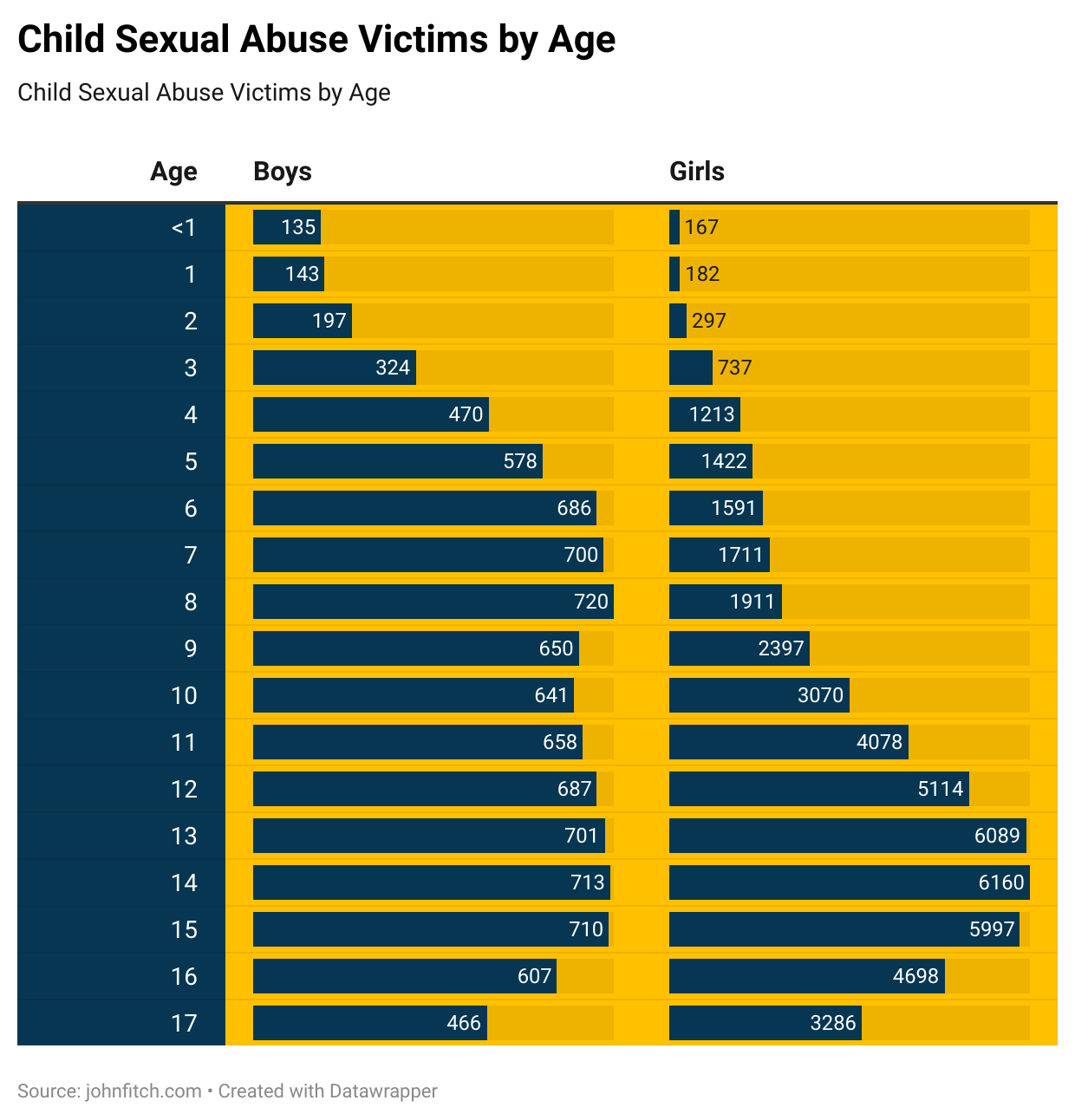Every 9 minutes, U.S. child protective services finds evidence for a child sexual abuse claim. Overall, 1 in 4 girls and 1 in 13 boys are sexually abused, with 30% of child sexual abuse cases never reported. Our analysis looks beyond these stark statistics to consider a national epidemic.
Child sexual abuse is defined as any sexual activity with a minor (a person under 18 years old) where consent is not or cannot be given. After neglect and physical abuse, child sexual abuse is the third most common type of child abuse. As study data reveals, there are 795,066 people on national sexual offender registries.
Our analysis shows that 93.6% of perpetrators are male; in the majority of those cases, they’re over 30 years old. 57.5% of perpetrators are white, 16.1% black, 12.1% Native American, and 11.8% Hispanic.
Child Sexual Abuse Victim Statistics
In 2022, there were 60,371 instances of child sexual abuse reported. According to study data, of those numbers, girls made up the vast majority of victims at 50,334 or 83.4% compared to boys at 9,845 or 16.3%.
The likelihood of boys being abused is higher before the age of 6, a period during which they make up between 44.7% and 27.8% of child sexual abuse victims. From around the age of 3 years, girls make up a minimum of 70% of child sexual abuse victims, a number that rises above 85% by the age of 11. Generally, children between the ages of 7 and 13 are at the highest risk of being sexually abused.
The highest risk period for girls is between the ages of 13 and 15, during which they consistently comprise over 89% of all child sexual abuse victims.
That said, boys may well underreport abuse due to stigma, shame, and the worry that revealing abuse may tarnish their reputation as they get older.
As digital tools have become more sophisticated, their growing capabilities have been opportunistically misused by abusers. Predators use many facets of modern technology, including generative AI, to sexually abuse children online.
As our analysis uncovered, in 2023, NCMEC’s CyberTipline received over 36 million reports of suspected child sexual exploitation. Electronic service providers reported more than 104 million files containing suspected child sexual abuse material (CSAM), while IWF processed 392,665 reports that featured potential child abuse imagery.
Cybertip.ca received 28,116 reports of online child sexual abuse, including 203,436 URLs. INHOPE hotlines red-flagged 780,000 URLs with potential child sexual abuse content.
In 2023, IWF reported over 2 million images and videos featuring children between the ages of 3 and 13. INHOPE noted that 83% of CSAM victims were within that same age range, with 95% female.
Stereotypically, younger children are thought to be more synonymous in child sexual abuse content than teens, and girls are more frequently involved than boys. However, our research shows that boys tend to appear more often in especially violent or extreme material.
Although most abusers still gain offline access to children, the internet has made it easier than ever to remotely find, contact, and exploit young people.
Children routinely use the internet to make friends or find romantic connections. Sadly, predators use the same space to manipulate and groom children. Often, minors engage in sexually flirtatious behaviour with opportunistic adults without appreciating the inherent dangers.
Online grooming is very similar to in-person grooming. Social media platforms, gaming communities, and messaging apps are regular predator hunting grounds.
Abusers gradually build trust, sometimes even with the child’s family or caregivers. They then conduct conversations through private messages or even more private encrypted apps before isolating the child.
According to our analysis, more than 1 in 5 children report online sexual interaction with an adult. Examples include being asked to send explicit photos and receiving sexual messages and other inappropriate content.
It may be possible to spot signs of sexual abuse in a child, as some behavioral red flags may manifest.
Manifestations of Abuse
Yet, the type of manifestation can depend on the age range of the abused child. Very young children 7 and under may work through trauma by using play to reenact parts of an abusive experience.
Children at this age may also suffer from incessant nightmares or be prone to one of two behavioral extremes and be either very clingy or become distant and withdrawn. They may also exhibit sexualized behavior that’s atypical for their age.
Children between the ages of 7 and 12 manifest signs of abuse differently. They may suffer from anger issues or be irritable and anxious and may begin to exhibit early signs of depression or low self-esteem.
They may also struggle at school due to a short attention span. Our analysis also underscores the possibility that they might be confused or guilt-stricken regarding their abuse.
All these underlying issues may compound emergent teenage manifestations of more acute mood swings, more prolonged withdrawal, and risky sexual or drug-related behaviour. Children 13 and older may even self-harm and attempt or commit suicide.
How Child Sexual Abuse Affects Adulthood
As sexually abused children move into adulthood, study data confirms that earlier manifestations of trauma may continue to evolve. An adult once sexually abused as a child may suffer depression, PTSD, poor physical health, and mental illness.
They may also struggle with drug dependency, suicidal thoughts, identity issues, exhibit erratic behaviour, and encounter relationship and intimacy difficulties. Risky sexual behavior is not uncommon; criminal behavior is sometimes a linked factor. And revictimization, replicating abusive patterns in a potentially unending cycle of self-sabotage may occur.
Such manifestations may not be immediately apparent and may take years to surface. Yet, once prevalent, such manifestations can become consistent and enduring factors that require ongoing support and care.
Lessening the Likelihood of Childhood Sexual Abuse and Trauma
Our analysis has emphasised some of the things all parents can do to both safeguard their children and provide the right level of stability. Something as simple as making more time in the day to speak to or play with your child can make an enormous difference to their emotional well-being.
Regular routines can provide structure and security, and physical and emotional support is crucial. Monitoring your child’s use of devices and the Internet is increasingly vital.
If you feel that you need help building a relationship with your children, make use of one of the many parental skills training programs available.
Once they step outside your home, your child is at potential risk of harm. But you can still take important steps that can make a difference. For example, making sure you know who is supervising your child is paramount.
At The Fitch Law Firm, we’re passionate about helping you to seek the right reparations for crimes committed against you and your loved ones. Please do get in touch with any questions – we’re ready to help.

